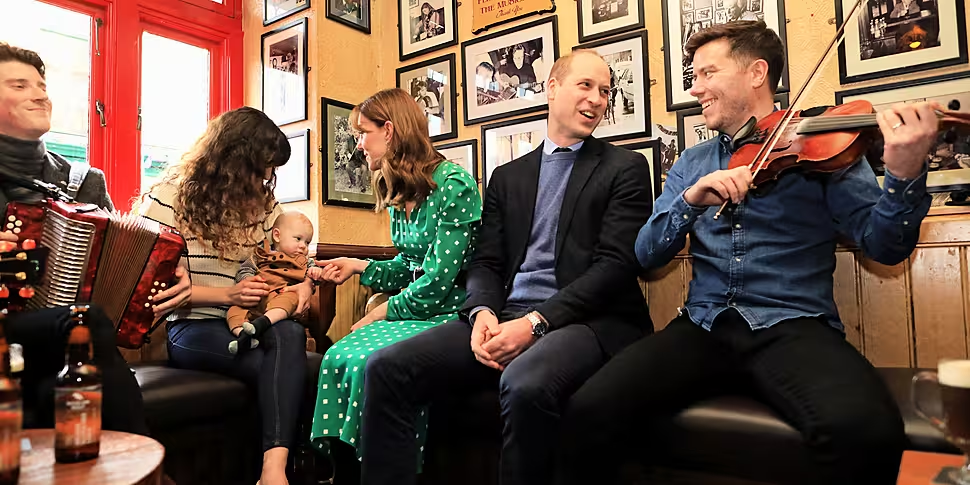Looking back at early 2020, some of the events seem like they were years ago rather than just 12 short months.
There were the deadly bushfires that devastated parts of Australia, with haunting images and images broadcast globally. Tensions flared between Iran and the US yet again, after the US assassinated Iranian general Qasem Soleimani in an airstrike in Iraq (an incredibly tense period which saw a Ukraine International Airlines plane shot down by Iranian forces after being mistaken for a US missile). In Ireland, a political controversy flared after the then Government proposed a commemoration of the Royal Irish Constabulary - an event which was promptly cancelled amid major backlash.
Such extraordinary moments aside, it seemed clear there were going to be three guaranteed major news stories dominating the headlines for much of the year - Brexit; an Irish election near the start of the year; and a US election in November. Those three predictable events did happen, but little did we know they’d be far from the biggest news stories of 2020…
It may have been a month after New Year’s Eve, but Brexit supporters enjoyed their major moment of celebration on 31st January when the UK formally left the EU (albeit while entering into a 12-month transition period). It was a moment of frustration and despair for those who opposed the UK’s exit from the bloc, of course. It also was far from the last we heard of Brexit - while it no longer dominated the news agenda like it did during 2018 and 2019, the Brexit trade talks remained a constant source of uncertainty during 2020. Barring a few moments of high drama - such as the British threat to violate international law by breaching the withdrawal agreement - Brexit was very much something being discussed behind closed doors (and across virtual conference calls) in Brussels and London. Negotiations on a trade deal would ultimately continue right up to the wire - only in the days before Christmas did we finally get a hint a deal could be on the way.
Listen back to part one of our political correspondent Sean Defoe's year in review below
Elections (part one)
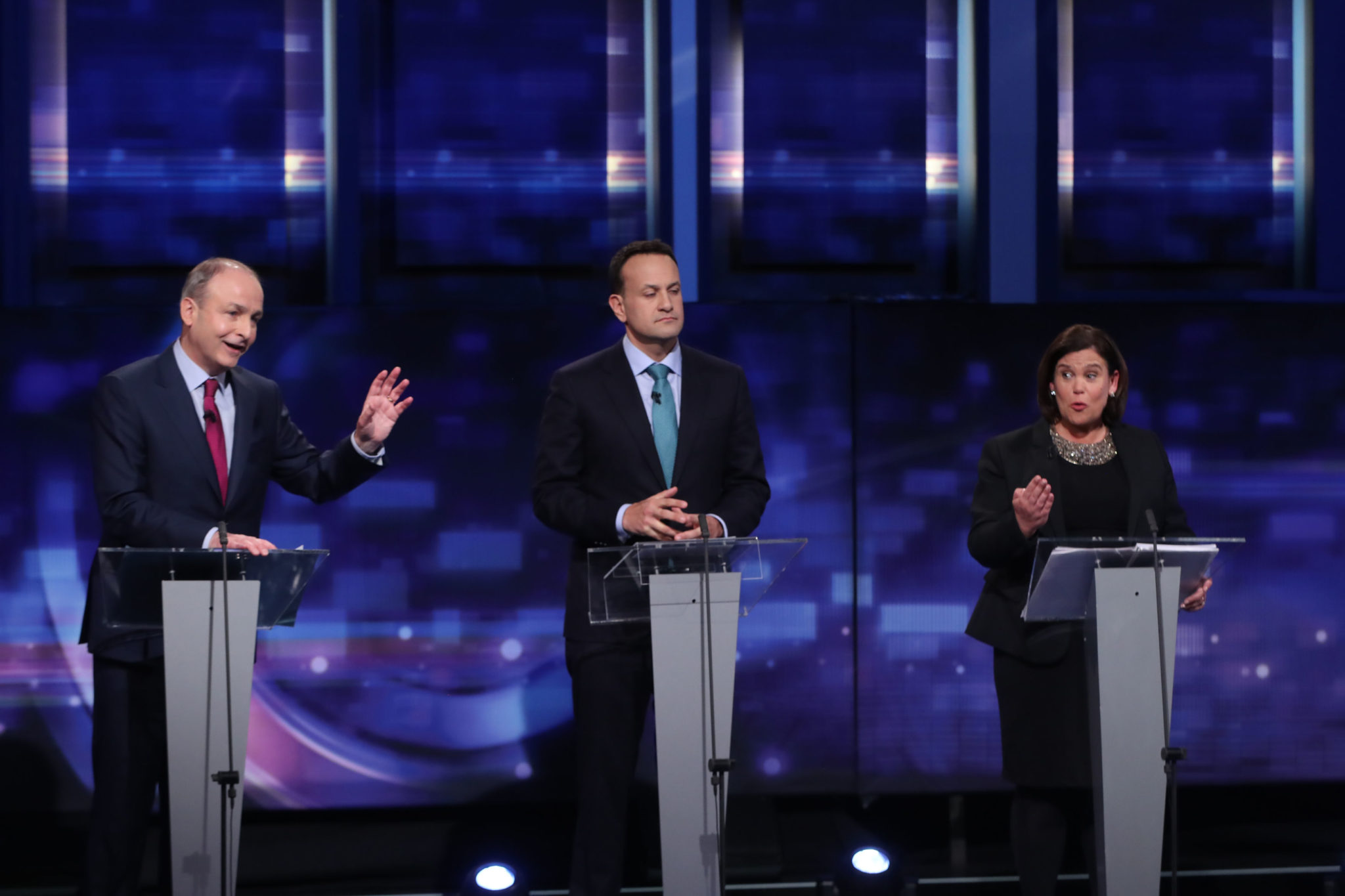 (left to right) Fianna Fail leader Micheal Martin, Fine Gael leader Leo Varadkar and Sinn Fein President Mary Lou McDonald during the final TV leaders' debate at the RTE studios in Donnybrook, Dublin. Picture date: Tuesday February 4, 2020. Photo:Niall Carson/RollingNews.ie/Pool
(left to right) Fianna Fail leader Micheal Martin, Fine Gael leader Leo Varadkar and Sinn Fein President Mary Lou McDonald during the final TV leaders' debate at the RTE studios in Donnybrook, Dublin. Picture date: Tuesday February 4, 2020. Photo:Niall Carson/RollingNews.ie/PoolWhile Brexit is often seen as a potentially catastrophic threat for Ireland, it turned out there were more pressing concerns facing the country early this year - and not just the growing reports of a mysterious respiratory disease in the Wuhan area of China. January and February in Ireland were instead dominated by coverage of the impending general election. From the new year, it was clear an election would happen sooner rather than later as the outgoing government faced a series of no confidence motions. The minority government was increasingly fragile, and Leo Varadkar made it official on January 14th: there would be an election just a few weeks later on February 8th.
One unusual detail to note: it was to be a Saturday election, the first since 1918.
The campaign itself was a short one, and in many ways unremarkable. With opinion polls showing a close race, party leaders inevitably faced a particular question again and again: who would you be willing to go into government with? Fianna Fáil’s Micheál Martin was quite firm in ruling out a grand coalition with Fine Gael. Leo Varadkar, in contrast, was more open to the prospect during the campaign. We all now know how it turned out.
The biggest controversy was over the series of leaders’ and party debates held over the course of the campaign. Aontú campaigned, unsuccessfully, to be included in the two major all-leader televised debates. Sinn Féin, meanwhile, campaigned to be included in the two head-to-head debates featuring Micheál Martin and Leo Varadkar. Ultimately, the Sinn Féin leader didn’t take part in the first debate - but RTÉ eventually invited Deputy McDonald to take part in the second, amid an increasingly strong showing for Sinn Féin in pre-election opinion polls.
Those opinion polls proved accurate. As voting stopped and the exit poll dropped, it became clear that the election had produced a three-way tie - with Fianna Fáil, Fine Gael and Sinn Féin each receiving a near equal share of the vote. It was a remarkable result, and an historic shattering of the ‘civil war’ politics that have dominated Irish politics since independence. As the count continued (slowly), the results became clear: 38 seats for Fianna Fáil, 37 for Sinn Féin and 35 for Fine Gael. It also proved a big day for the Green Party (up to 12 seats from three) and Social Democrats (up to six seats from just two).
As the dust settled, the focus swiftly turned to government formation. The parliamentary arithmetic was, to put it frankly, very messy indeed. Sinn Féin quickly began its efforts to form a left-wing coalition. But they faced an uphill battle. As People Before Profit’s Richard Boyd Barrett observed in February: it appeared they ‘didn’t quite have the numbers’ for a left-led minority government. Indeed, there was no obvious path forward for Sinn Féin, Fine Gael or Fianna Fáil - any coalition would require two of those three parties. Either old enemies would have to put their differences aside, or we’d be looking at the prospect of the second election in a year. That second election didn’t come to pass, but it would feel like a lifetime before we finally had a new government in place...
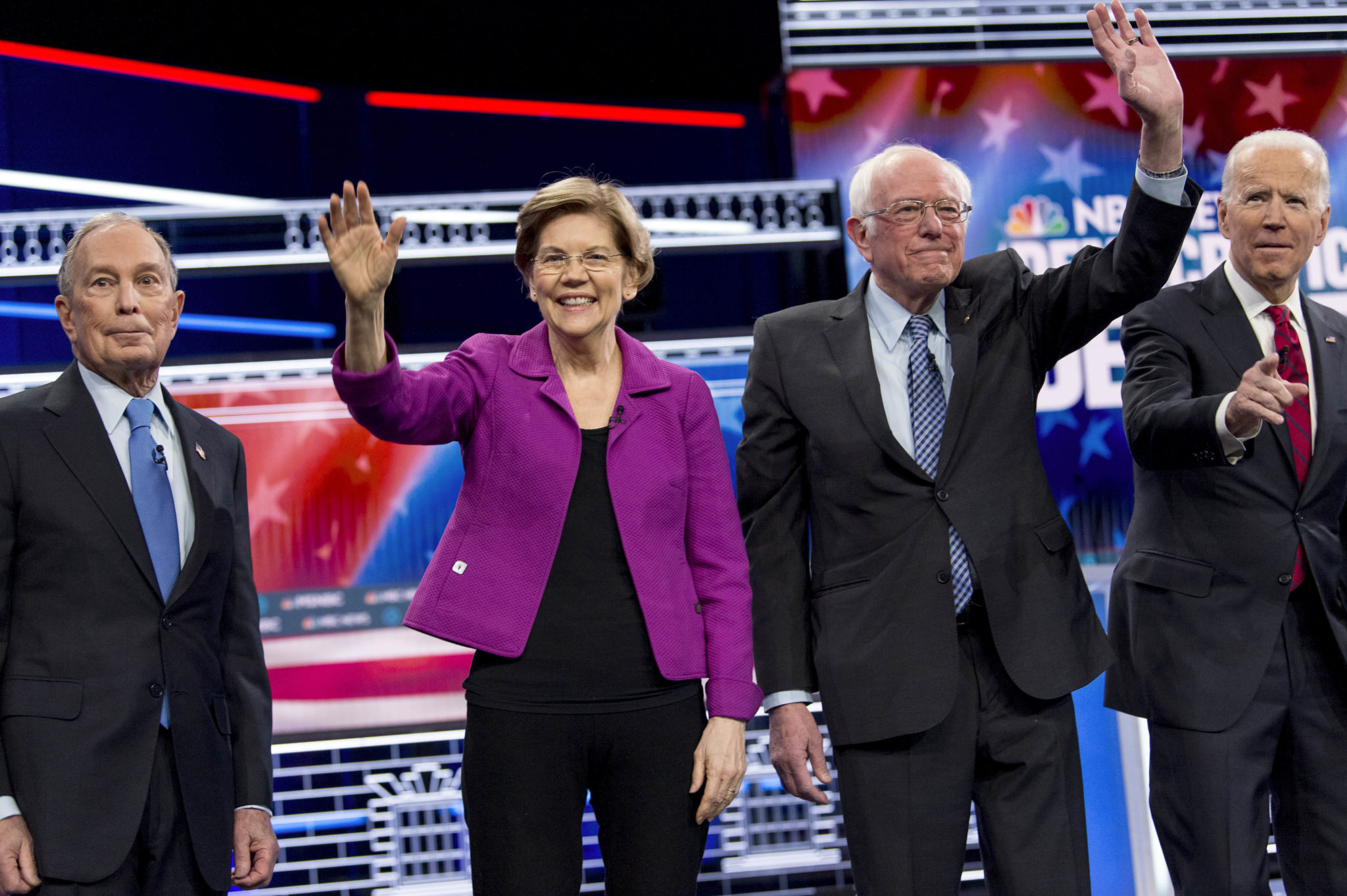 February 19, 2020, Las Vegas, Nevada, USA: From left, Democratic presidential candidates MICHAEL BLOOMBERG, ELIZABETH WARREN, BERNIE SANDERS, JOE BIDEN pose for photographers ahead of the NBC News & MSNBC Democratic Debate at Paris Las Vegas.(Credit Image: © Brian Cahn/ZUMA Wire)
February 19, 2020, Las Vegas, Nevada, USA: From left, Democratic presidential candidates MICHAEL BLOOMBERG, ELIZABETH WARREN, BERNIE SANDERS, JOE BIDEN pose for photographers ahead of the NBC News & MSNBC Democratic Debate at Paris Las Vegas.(Credit Image: © Brian Cahn/ZUMA Wire)In the US, meanwhile, Democratic presidential primary season was well underway. Two candidates had already dropped out towards the end of 2019 - Beto O’Rourke and Kamala Harris (the latter of whom we’d be hearing from again before 2020 was out, despite a once much-hyped presidential bid fizzling out). January saw more drop outs: Julian Castro and Cory Booker finished their campaigns before the Iowa caucuses kicked off primary season in earnest in early February. A whirlwind month of voting across the US saw two clear frontrunners emerge: former vice president Joe Biden, and independent senator Bernie Sanders. A few other candidates - including Elizabeth Warren, Michael Bloomberg, Amy Klobuchar and Pete Buttigieg - held on until early March, but the two veteran politicians were too far ahead to be caught.
It was very much a case of an experienced, centrist candidate facing a progressive, left-leaning one. It in fact was a direct echo of the 2016 primaries, where Sanders emerged as an underdog when up against Hillary Clinton. But like 2016, the independent’s efforts would prove unsuccessful, despite significant grassroots support.
Despite Sanders winning several key states, Biden was gaining an insurmountable lead - enhanced by the endorsements of the likes of Pete Buttigieg and Amy Klobuchar as they dropped out of the race. While many primary races were being rescheduled due to COVID-19 concerns, it gradually became clear that there was no path forward for Sanders. He withdrew from the race in early April: Joe Biden was the presumptive Democratic presidential candidate.
An unprecedented crisis
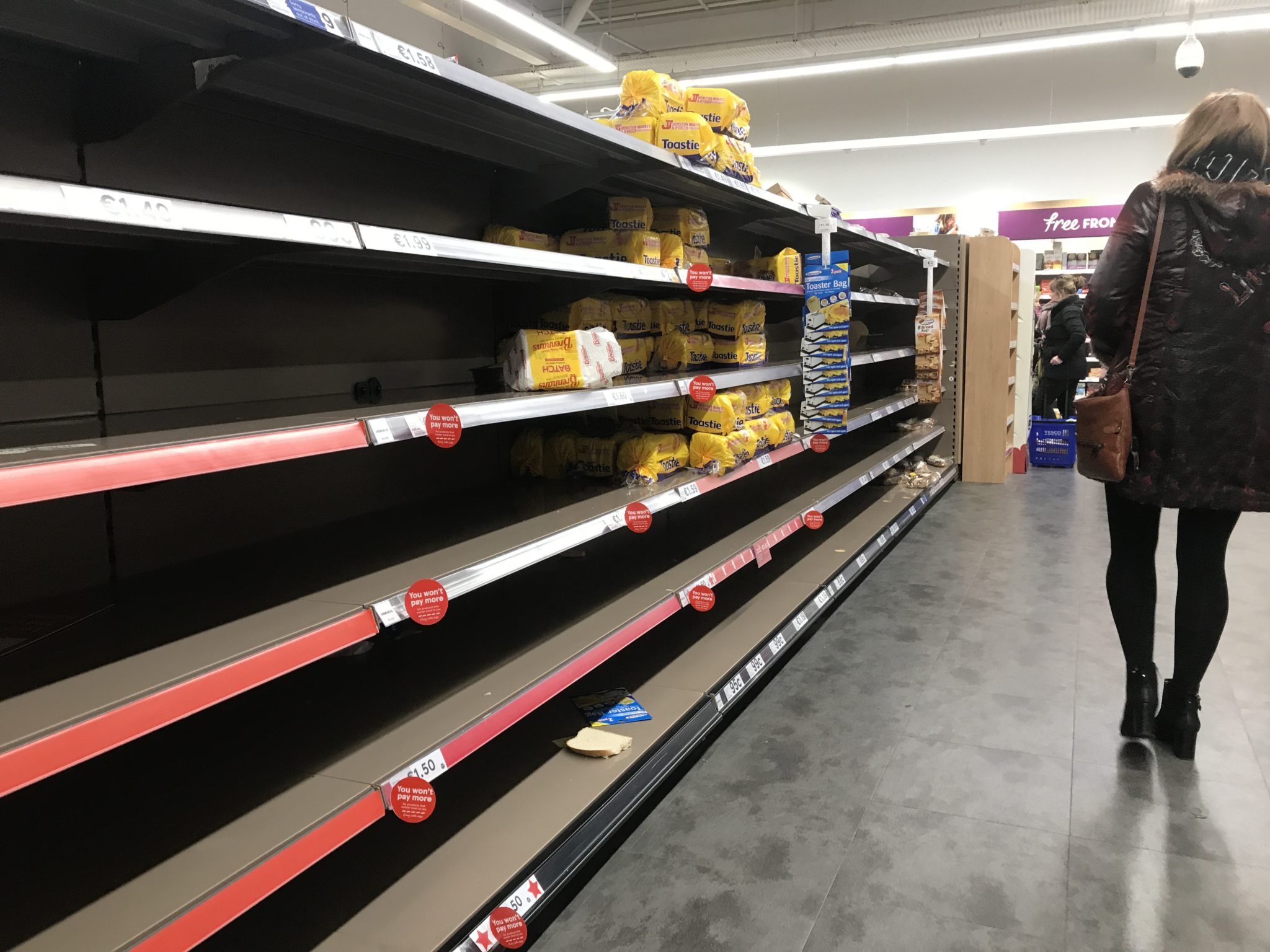 12/3/2020 Bread shelves are empty in Tesco's Newbridge Co Kildare after the Taoiseach made his speech in Washington about COVID-19 (Coronavirus) situation in Ireland. Photo: RollingNews.ie
12/3/2020 Bread shelves are empty in Tesco's Newbridge Co Kildare after the Taoiseach made his speech in Washington about COVID-19 (Coronavirus) situation in Ireland. Photo: RollingNews.ieBack in Ireland, government formation efforts were continuing apace. In early March, the country had a high-profile visit from Prince William and his wife Kate - a lively tour of Ireland which now seems like it happened an age ago. As usual, Leo Varadkar prepared to travel to Washington DC for his traditional St Patrick's Day meeting with the US president.
But concerns were increasingly growing about a novel coronavirus that was spreading beyond the borders of China. The escalating COVID-19 situation in the north of Italy proved the first major outbreak in Europe. In an extremely rare development, authorities here began warning against all but essential travel to affected areas - an extraordinary move given the nature of the modern European Union. By March, frightening stories were emerging of overwhelmed hospitals and mounting death rates - with authorities closing large swathes of the country off in a bid to contain the spread of the virus.
As the situation in Europe worsened, it was only a matter of time before the virus reached Ireland. It finally did on 27th February, when a case was confirmed on the island - in that case, someone who travelled from Italy to Dublin Airport and then on to Northern Ireland. Two days later, the first case was confirmed in the Republic.
Things moved rapidly from there. Initially it was a number of schools and workplaces closing temporarily as a precaution after confirmed or suspected coronavirus cases. Dublin’s St Patrick’s Day Parade was cancelled on March 2nd - all other nationwide parades were cancelled a few days later. Terrifying predictions began to emerge - one suggesting Ireland could see as many as 1.9 million cases of the virus. All the while, confirmed cases began creeping upwards - including the first among people who hadn’t travelled to impacted areas. On March 11th, Ireland had its first COVID-19 related death.
Everything escalated on March 12th. Taoiseach Leo Varadkar - who was in Washington at the time - made a special announcement from the steps of a DC hotel: schools, crechés universities and state facilities such as museums would close for two weeks in response to the worsening pandemic. New phrases such as ‘social distancing’ immediately entered our vocabulary. Ministers - some of whom had lost their Dáil seats just weeks before - had to make massive financial decisions and commitments, on a scale unheard of in Irish history. People were urged against panic buying as crowds rushed to pick up essentials in supermarkets. Sports matches were suspended. People were asked to work from home wherever possible. On March 15th, pubs were asked to stay shut for at least two weeks.
Streets around the country were eerily quiet on St Patrick’s Day - there were no crowds, no parades, no parties. At around 9pm that evening, Leo Varadkar made a special announcement to the country on a St Patrick’s Day few people will forget. He said authorities expected 15,000 cases or more by the end of the month, and urged people “to come together as a nation by staying apart from each other”.
Ten days later, the full lockdown began. People were told to stay at home wherever possible - with the only exceptions for the likes of essential work, short daily exercise, or grocery shopping. It would ultimately last right through Easter and into mid-May - only on May 18th were some additional shops and businesses allowed reopen as part of a phased plan to ease restrictions. It would be June before many retailers and restaurants were able to reopen. ‘Wet pubs’ in Dublin still haven’t been able to open their doors, and likely won’t be able to for months to come.
For many, the lockdown period will be a bit of a blur, but there were many extraordinary moments. The cancellation of Junior Cert exams - followed by the Leaving Cert after weeks of uncertainty and political controversy. The introduction of the Pandemic Unemployment Payment and Wage Subsidy Scheme, which saw the Government supporting hundreds of thousands of people who were suddenly out of work. As people were stuck at home, unusual stories emerged due to the unique nature of the moment in history - from a controversy over fruit pickers being flown in to the country to help the harvest, to discussions over where the Dáil could meet while allowing for social distancing. Some businesses collapsed as a result of the unprecedented lockdown - department store chain Debenhams shut its doors for good in Ireland, prompting a months-long campaign by its former workers for better financial supports and benefits.
In lockdown, some pop culture did thrive. Tiger King - the wild true crime documentary - was a March hit for Netflix. The dark romantic drama Normal People would become appointment viewing when it started broadcasting in April. Ditto the hit Michael Jordan documentary The Last Dance. Many people with a Nintendo Switch found themselves tending to their Animal Crossing: New Horizons villages. In surreal times, these little tastes of normality and routine were invaluable.
A new government
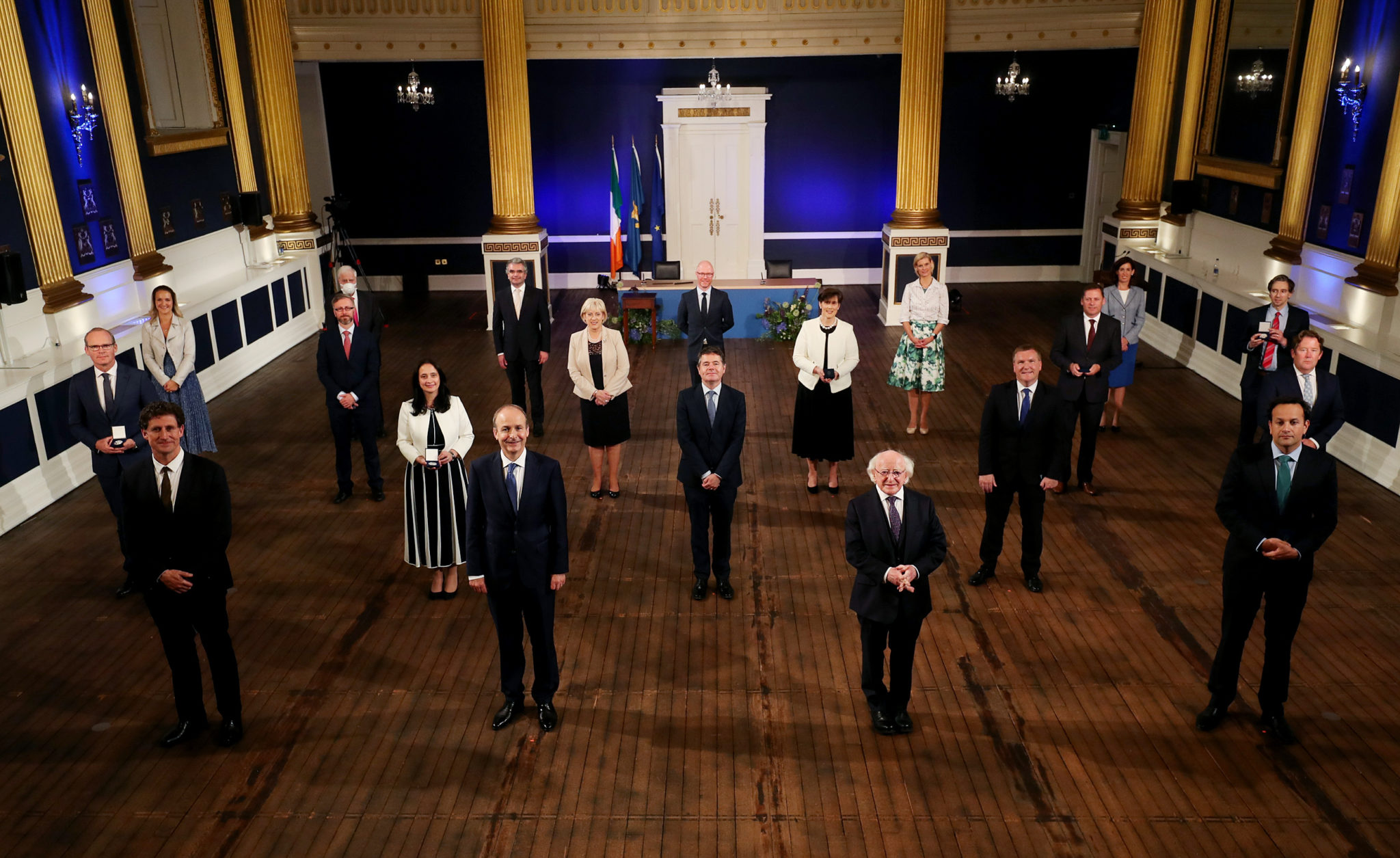 27/06/2020 President Higgins presents new ministers with their Seal of Office.
27/06/2020 President Higgins presents new ministers with their Seal of Office.As the country dealt with unprecedented economic and social disruption, negotiations on the formation of a new Government were picking up momentum, and the practicalities of electing a new Taoiseach had to be considered. Despite Sinn Féin’s efforts to form their own coalition, it became clear that it would be the two old civil war rivals - Fine Gael and Fianna Fáil - who’d put together a coalition. After lengthy talks, the Green Party emerged as the likely third coalition partner - after other small parties such as Labour and the Social Democrats ruled out going into government with FG and FF.
A programme for government was agreed, and the three parties began the process of convincing members to support it. Despite opposition from some high-profile figures within the Greens and Fianna Fáil, all three parties signed off on the deal on June 26th. The full Dáil met at the Convention Centre the following day and the new government was official. It was agreed Micheál Martin would serve as Taoiseach for the first half of the new government’s term, with Leo Varadkar taking over at the end of 2022. Ministries were split among the three parties - they received their seals of office in a cavernous hall in Dublin Castle, as the traditional trip to Áras an Uachtarain was not possible with social distancing guidelines.
That was a Saturday - on Monday COVID-19 restrictions were further eased, with many people rushing to hairdressers and barbers for their first proper hair cuts since February or March. In many ways, it was the first time things felt they were getting back to normal after months of extraordinary restrictions. But the COVID-19 crisis was far from over, and the new Government had a few very rough months ahead of them...
You can listen back to part one of Sean Defoe's year in review below:


